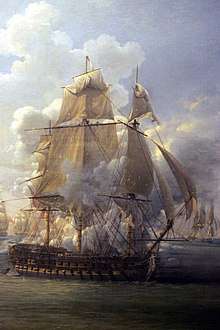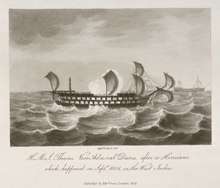HMS Hercule (1798)
HMS Hercule was a 74-gun third rate ship of the line of the Royal Navy. She was previously Hercule, a Téméraire class ship of the line of the French Navy, but was captured on her maiden voyage in 1798, and spent the rest of her career as a British ship. She was broken up in 1810.
 Fight of the Poursuivante – 28th of June 1803, by Louis-Philippe Crépin (detail) HMS Hercule receives raking fire | |
| History | |
|---|---|
| Name: | Hercule |
| Namesake: | Hercules |
| Ordered: | 14 August 1793 |
| Builder: | Lorient shipyard |
| Laid down: | June 1794 |
| Launched: | 5 December 1797 |
| Completed: | March 1798 |
| Captured: | 21 April 1798 |
| Name: | HMS Hercule |
| Acquired: | 21 April 1798 |
| Fate: | Broken up in December 1810 |
| General characteristics [1] | |
| Class and type: | Téméraire-class ship of the line |
| Tonnage: | 1876 bm[2] |
| Displacement: |
|
| Length: | 55.87 metres (183.3 ft) (172 pied) |
| Beam: | 14.90 metres (48 ft 11 in) |
| Draught: | 7.26 metres (23.8 ft) (22 pied) |
| Propulsion: | Up to 2,485 m2 (26,750 sq ft) of sails |
| Armament: |
|
| Armour: | Timber |
French career and capture
.jpg)
During her maiden journey, on 21 April 1798, and just 24 hours out of port, she was captured by the British ship HMS Mars after a violent fight at the Battle of the Raz de Sein, off Île de Sein near Brest. Hercule attempted to escape through the Passage du Raz, but the tide was running in the wrong direction, and she was forced to anchor, giving the British the chance to attack at close quarters. The two ships were of equal force, both seventy-fours, but Hercule was newly commissioned; after more than an hour and a half of bloody fighting at close quarters she struck her colours at 10.30 pm, having lost — by her own officers' estimate — 290 men killed and wounded. On Mars 31 men were killed, including her captain, Alexander Hood, and 60 wounded. Captain Louis Lhéritier of Hercule was wounded by sabre and spike leading his boarding party.[3]
The Hercule was recommissioned in the Royal Navy as HMS Hercule.
British career
In mid-1803, the squadron under Captain Henry William Bayntun, consisting of Cumberland, Hercule, Bellerophon, Elephant, and Vanguard captured Poisson Volant and Superieure.[4] The Royal Navy took both into service.
In May 1803, Hercule's captain Solomon Ferris died suddenly on board the ship.
On 28 June 1803, during the Blockade of Saint-Domingue, Hercule was under the command of First Lieutenant John B. Hills, who was acting captain because Captain Ferris had died the previous month. She encountered the French frigate Poursuivante and the corvette Mignonne, and Hercule attempted to capture Poursuivante. However, Poursuivante outmaneuvered Hercule and delivered raking fire. Hercule (Louis-Philippe Crépin immortalised the incident in a painting.) HMS Goliath then captured Mignonne.
Hercule, under Captain Dun, participated in the failed attempt in January 1804 to capture Curaçao .

Hercule, was caught in a Hurricane off San Domingo between 4 and 11 September 1804, both she and HMS Theseus were badly damaged, but eventually survived to reach Port Royal on 15 September.
Officers in 1803–1804
In the book, 'The Naval History of Great Britain' by William James lists most of the officers on board.
- Captain: Solomon Ferris, Feb 1803 – 27 May 1803[5]
- Acting Captain: Lieutenant J B Hills, June 1803[6]
- Captain Richard Dalling Dunn, 1803 [6]
- Lieutenant J.B.Hills[6]
- Lieutenant S. Perrot
- Lieutenant Nesbit Willoughby[6]
- Lieutenant William Woolsey [6]
- Royal Marines Lieutenant Edward Nicolls[6]
The commissioning captain, Captain Solomon Ferris proved a strong judge of character. His personally chosen lieutenants achieved success in the navy with two of them being knighted.
- Lieutenant J B.Hills reached the temporary position of Acting Captain.
- Lieutenant S. Perrot reached the rank of Captain in 1806
- Lieutenant Nisbet Willoughby reached the rank of Rear Admiral and was Knighted
- Lieutenant Edward Nicolls reached the rank of Lt. Col and was Knighted
- Lieutenant William Woolsey reached the rank of Commander at 20 years of age, HMS Papillon. Woolsey's capture of a French sloop man-of-war in Jamaica in April 1805 was replicated in the film Master and Commander. Drowned in a shipwreck 1805 crossing the Atlantic on convoy duty with HMS Vanguard
Perrot was mentioned in dispatches after losing an arm to a Dutch cannonball shot moments after swapping seats with Lt. Willoughby during the siege of Curaçao.
Citations
- Clouet, Alain (2007). "La marine de Napoléon III : classe Téméraire – caractéristiques". dossiersmarine.free.fr (in French). Archived from the original on 23 March 2013. Retrieved 4 April 2013.
- Colledge, J. J.; Warlow, Ben (2006) [1969]. Ships of the Royal Navy: The Complete Record of all Fighting Ships of the Royal Navy (Rev. ed.). London: Chatham Publishing. ISBN 978-1-86176-281-8. P. 161
- Quintin, Danielle et Bernard (2003). Dictionnaire des capitaines de Vaisseau de Napoléon. S.P.M. pp. 242–243. ISBN 2-901952-42-9.
- "No. 15620". The London Gazette. 13 September 1803. p. 1228.
- The European Magazine and London Review. p. 159.
- James, W.; Chamier, F. (1837). The naval history of Great Britain, from ... 1793, to ... 1820, with an account of the origin and increase of the British navy. Chamier. 3. p. 285. Retrieved 23 February 2017.
References
- Winfield, Rif (2007). British Warships in the Age of Sail 1793–1817: Design, Construction, Careers and Fates. Seaforth. ISBN 1-86176-246-1.
External links

- Benyon, P. (2011). "HMS Hercule". Index of 19th Century Naval Vessels.